SilverStone Sugo SG09 Case Review: Someone at SilverStone Loves Tetris
by Dustin Sklavos on October 20, 2012 6:35 PM EST- Posted in
- Cases/Cooling/PSUs
- SilverStone
- MicroATX
Noise and Thermal Testing, Stock
Up until this point I've been casually suggesting that the SilverStone Sugo SG09's performance is, frankly, pretty stellar. As you'll see that's mostly true, as it's pretty hard to go too wrong when you have a 180mm fan blowing almost directly on to your processor. This is something SilverStone has traditionally understood pretty well: the best cooling is direct cooling. It's also why their designs oftentimes deviate a bit from the norm.
You'll note that I tested with our standard ATX/Micro-ATX testbed and not the Mini-ITX one. I elected to do this both for time concerns and to demonstrate what should be obvious when you're done looking at the charts: if the SG09 can handle an overclocked Micro-ATX build (spoiler alert: it can), then it should have no trouble with a powerful Mini-ITX rig. That said, I know it would've been ideal to see how the SG09 fared against something like the BitFenix Prodigy; to that end, all I can say is that these are two designs that look like they occupy similar space in the market, but they went very different directions.
Ambient temperatures were between 23C and 24C during testing. The top intake fan actually has a fan speed selector on the back, and so the SG09 was tested at both low and high settings.
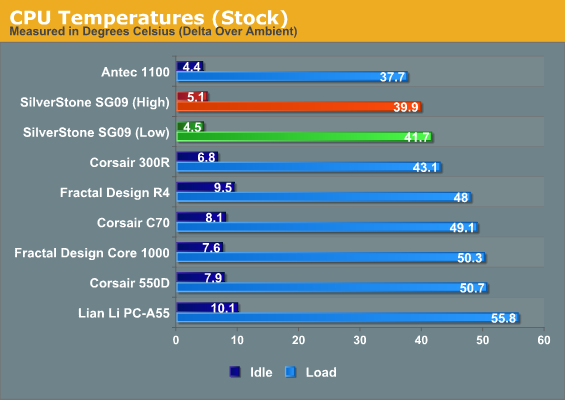
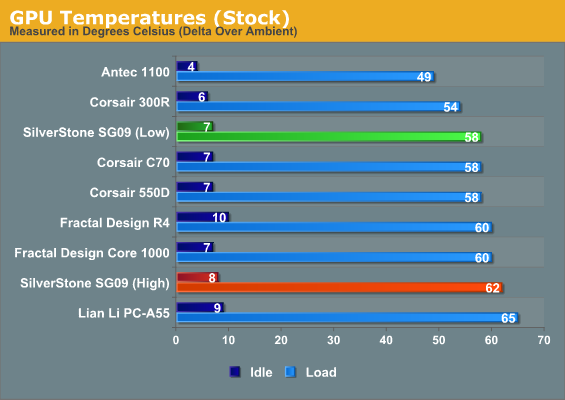

Storage thermals aren't great; that's not surprising, something had to give. Graphics thermals are okay, but the CPU thermals are fantastic. I have some theories about the video card but I'll save them for later; for now, it's worth noting that raising the fan speed of the top intake fan actually increases temperatures for certain components, sacrificing efficiency elsewhere for brute force in cooling the CPU.
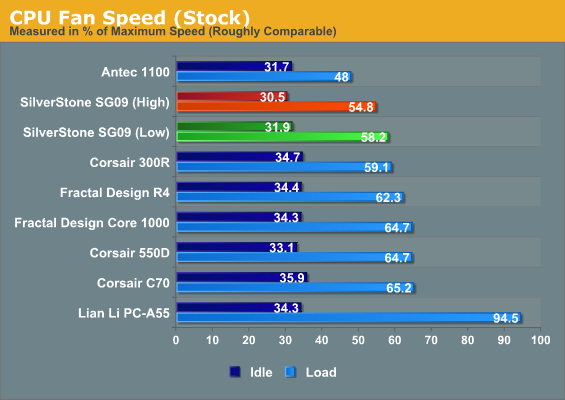
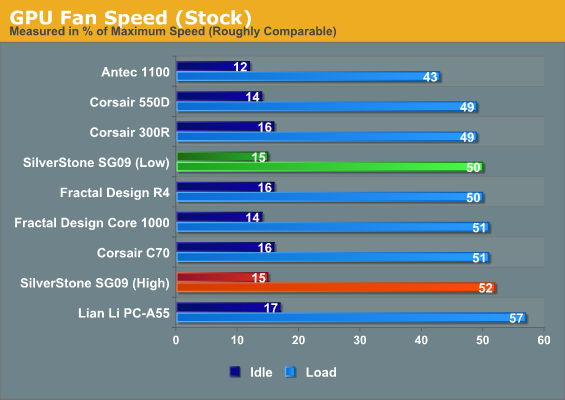
As you can see, you don't gain much headroom on the CPU running the top intake at a high speed, and in fact you actually lose some on the graphics card. I suspect this is due to the cooling design of our testbed video card, and I imagine the SG09 may be better suited for blower-style coolers given the position of the intake fan on the side of the case.
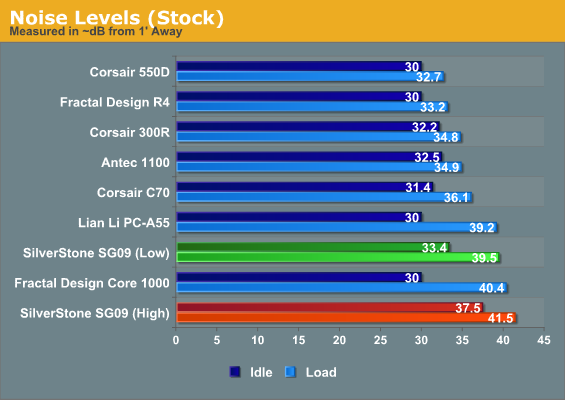
Unfortunately without any fan control for the exhaust fan or side intake, the SG09 is frankly on the loud side. SilverStone is using their Air Penetrator fans all over the case, and while these fans are fantastic at their job, they can produce a decent amount of noise without some kind of fan control. Given the thermal headroom available in the SG09 it may be prudent to install an expansion slot-based fan controller and dial down the fans.










45 Comments
View All Comments
EnzoFX - Saturday, October 20, 2012 - link
Is it me or does that look like a TJ-08E that was needlessly made ugly externally.As for going with a slim ODD, I applaud whenever cases do this. This is a must in an ITX form factor IMO, since it's all about saving space. Not so much large ITX cases however, so to each his own. Though I will argue that there is some merit in saying a full size ODD is more practical for someone trying to save money or whatever, HOWEVER, is it not more logical that they may not even use one? Hence I'd rather let the small ODD be wasted space, as opposed to dedicated much more of it to a full sized one. Optical drives are on the decline are they not? Unless this is your only computer in the house, leave ripping to another computer and save money by ditching the ODD.
MadAd - Sunday, October 21, 2012 - link
I agree, Ive just done a build in a TJ08 with a full size optical, three standard HDD, one SSD (and i didnt use the drive cage at all,threw it out), an 11.5" dual fan graphics card, sound card etc, i threw out the silverstone fan and used a TY150, and also a H60 with a silent typhoon doing double duty as a rad cooler and exhaust fan - sounds hot? its not - cant get cpu over 53 degrees no matter what i throw at it, and its virtually silentLooking over the review makes wonder what on earth they were thinking, its ugly, noisy, wider than the 08 and no little cut out tabs all over the back to aid cable routing - for me that was the star feature of the 08 and theres not one on the 09.
i guess itll attract people that err on the side of caution and dont care if it sounds like an industrial vacuum in the corner of the room
MadAd - Sunday, October 21, 2012 - link
oh and i didnt have to use a modular psulmcd - Sunday, October 21, 2012 - link
Yes, the aesthetics are worse on this case but it's also 4 inches smaller in a dimension (appears to be height, but I can't tell):15.16" x 8.27" x 14.72" (TJ08-E, courtesy that review)
8.66" x 11.61" x 13.94" (this case with conversions via WolframAlpha)
HisDivineOrder - Sunday, October 21, 2012 - link
I think the bigger shame about the ODD issue is that the slim slot drives are so expensive even today when you'd wish they were easier to buy and cheaper to buy by now.tim851 - Monday, October 22, 2012 - link
Slot-in slimline drives cost under 40$ shipped on ebay. That's about 20$ more than a regular sized drive. Given that Mini-ITX (outside the world of Atom) is really not the best bang-for-the-buck, I'd consider 20$ more quite reasonable.96redformula - Saturday, October 20, 2012 - link
I finished building a new computer with this case several days ago and it was definitely more time consuming than typical builds. Looks great, fantastic air flow, and super quiet.My only gripes are that the front could use a bit of tweaking to optimize the looks, and secondly you cannot use the 120mm fan on the side because the connection to the power supply will be in the way.
Highly recommend to anybody wanting a case they can put on their desktop and run a powerful rig in the smallest space possible.
EnzoFX - Saturday, October 20, 2012 - link
So since it's mATX, does that mean that the only benefit here is being able to run dual GPU's in a small space? Or perhaps overclocking cpu's to extremes what with being able to run a full sized CPU HS/F.My overall criticism is that it isn't someone really looking to go small, it's someone that wants all the power, and size being the 2nd priority. Because even making one sacrifice (take your pick, cpu hs/f size, PSU, or losing 2nd graphics card), will yield smaller cases, and more attractive ones at that. There are even some that will hold more drives than this does.
MonkeyPaw - Saturday, October 20, 2012 - link
To me, the benefits are obvious. You get more expansion possibilities with mATX, the boards are generally cheaper than ITX, there are more mATX boards to chose from, and you can use standards parts. You end up with a small, powerful build that doesn't require lots of expensive or hard-to-find components. I would love to build a system with this case.EnzoFX - Saturday, October 20, 2012 - link
The only gain is expansion with mATX, and sure, more options. Prices are comparable these days. There are also no hard-to-find components. Not these days, everything has been well standardized, and there are many solid options. Sure not as many as full-ATX, but they are enough for even the budget oriented builds. I wish ITX cases would push the envelop in going small. I wish there were more use of flex-ATX PSU. Even those are readily available, and perfectly suitable for a mid-range gaming build. Let alone anything without a discrete graphics solution. It just feels like such a waste seeing oh so many ITX builds with a 40W+ PSU, be it microATX of ATX, that don't even have a mid-range card in it. Considering the high-end GTX 680's are the niche, what's the point of full ATX PSU in an ITX build.Granted I am not talking about full sized ITX cases such as these, I'm talking about the flip side for those really looking to save on space. There's a lot of ground that can be easily gained.